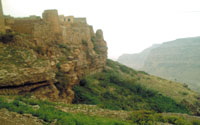
Thula: A historical place beyond compare [Archives:2008/1195/Last Page]
October 2 2008
 |
For the Yemen Times
Thula is a historical town located 45 kilometers to the northwest of Sana'a. The city is famous for its archeology and Al-Ghurab Mountain which is 2350 meters above sea level. In a precaution against invasion, the city was surrounded by a wall extending for two thousand meters. Entry to the city in through seven gates: Bab Al-Mishraq, Bab Al-Salam, Bab Al-Hadi, Bab Al-Faradhah, Bab Al-Mahamid, Bab Al-Meniah and Bab Al-Hisn. There are four barracks separating every gate from the other.
The city contains over 25 mosques, which indicates that education has been an outstanding feature throughout the history of the city, especially given that there were famous religious scholars in the city. There are also several popular markets in Thula including the blacksmith's market, carpenter's market, crops' market and meat market.
The legend city enthralls the observer in its architecture. Its houses are 5 to 7 storeys high. The nomination of the city came after Thula Bin Lubakha Al-Hemiari who lived in the city over two thousands year ago. The city was first built during the Sabaen age and, at that time, it was known as the village of Al-Talh village.
Inside the city, the streets are paved and intertwined. When walking around the city, every street leads the pedestrian to another as if by enchantment. Furthermore, there are passages under houses linking the streets and neighborhoods of the city. These passages are called rishah [a curved feather] and every rishah is 4 meters long and 2,5 meters high. They are used as passages for livestock. Other surface passages called Al-Arishah connect houses that are close to each other.
Architecture of Thula
The greatness of those who once lived the city is reflected in the construction of the city's houses, am impressive feat of past engineering. The ancient buildings are decorated with engravings in the rock of their external facades.
The qamareya above the buildings' windows are decorated with colored glass. The first floor of each building is used as stable for animals, the second for storing crops and the third as a sitting room for members of the family. The fourth floor is used for bedrooms, the penultimate floor as a sitting room for receiving guests, and the last as a kitchen.
Inside the buildings, the walls are decorated and carved under a cover of whitewash. The stepladders from one floor to another are usually paved and wide so that crops can be carried by animals up them. On the ground floor of the houses, there is a place used to put water in order to make it cold. This place is called bait al-shurbah.
The old market
The city's old market has been recently renovated. Situated in the center of the city, it consists of 30 shops that sell handicrafts such as the silver jambiya [traditional dagger], traditional clothes and miniatures of the city's historical buildings. Jars filled with water are spread throughout the market so that passersby can stop for a drink.
The Grand Mosque
Thula Grand Mosque was first built in the sixth century Hijra by Imam Abdullah Bin Hamzah. Its ceiling was built from wood. It includes a library to keep manuscripts and books of the Holy Quran. The mosques of the city are decorated both outside and inside some of them are topped by domes. The pillars of these mosques were built from stones in an engineering design beyond compare.
The city wall
The city is surrounded by a wall which is two kilometers long, five to seven meters high with a base three meters wide. Surprising, some of the stones in the wall weigh up to 900 kilograms. The wall is dotted with 26 towers, some of which are ten meters high are considered as castles to the city. It is said that the wall was first built during the Hemiarite rule.
To the west side of the city, one can see the stronghold of Thula, formerly called Al-Ghurab stronghold in the past. It contains an ancient castle with carvings dating back to the Hemiarite and Sabaen periods. The stronghold also contains two water pools carved in rock in addition to crop stores. There are two entrances to the stronghold without which access to the roof of the castle is impossible. A lot of stories have been narrated over the years about the castle and the battles that occurred in it, including the story of the famous battle between Imam Al-Mutahhar Bin Sharaf Al-Din and Turkish occupiers.
——
[archive-e:1195-v:16-y:2008-d:2008-10-02-p:lastpage]


